Welcome to the never ending stories part 2
Memory blob 12
Imitation is a form of flattery
Oddly it has taken 12 blogs for me to arrive at my favourite subject among the six legs. I have created two books on this subject – MIMICRY. Whereupon one insects mimicks another, or some object quite different from what it really is. Today lets look at the ‘imitating an object’ type – a blog on the imitating each other games, is coming soon.
What would you choose to look like if you were an insect, and didnt want to be eaten by the myriad predators searching for poor six legged critters ? Well poo of course. Many an insect, and their quite acceptable cousins the eight legs, are masters of this game. They can sit all day on top of leaves in plain sight, and escape most attacks. The first few pics are two moths, and a caterpillar of the Orchard butterfly, which generally look like splats…




I loves the one above, as it has that special glean only the freshest splat presents, and even a decoy bit of blue fruit-esque bit, where its bum is. No props are used. Its all pure moth.
Now spiders, the eight legs, take these games further. Most spiders can make several different types of silk. Sticky, translucent, fat, thin, white… Armed with this ability, the grand masters, in the genus Phrynarachne, spend time preparing the arena with extra fake splats, and dribbly bits emanating from where they sit.


These ones are facing up. The eecky brown bits at the bum end, are a special surprise. So here you are, fairly safe from predators as long as you sit still, but how do you eat anything without spinning a web, or chasing down your own prey ? Well, this brown area has special glands which exude very eeecky smells, sort of a cross between dead bodies and poo. And this attracts inquisitive, hungry flies, to their grizzly demise. Below…

And the last picture is not about bird poo, but it is still a bum story. In a Madagascan forest, I found this weird sight inside a hollow branch. A scarab beetle, sits thus with its bum end showing two eye spots, much larger than a creature its size would normally have at the head end. It is saying, dont bother me, I am a snake or other unfriendly creature wedged in this hidey hole…

Memory blob 13
My bread and butter
When I was a youngin, and the internet and facebook and all other ceaseless meaningless distractions had not yet taken over the grey cells of humans, there was a simpler sense of wonder. My early travels bothering insects with the macro camera all over the world, resulted in articles in Magazines like GEO. Stories about mimicking games and weird beauty, and all else six-leg, were actually sellable. Then came writing books, now up to 19 of the paper thinggis..
But remember the very sage story in the PIXAR film, The Incredibles: when the angry young super-wanna-be creates a way for everyone to have super powers and says to our hero – “when everyone is super, no one is special”
So here I am using the internet, of course, but it has so democratised and flooded information and pictures, that there is no way to get anyone’s attention. So death to making a living from photos and writing, and enter the DAY JOB !
Mine for the last 25 years has been the art of bothering mosquitoes. I now call myself a Medical Entomologist, and try to scare the bejeezus outta mozzies. They are not easily scared, but they sure are interesting and worthy opponents. In a different blog I will scare you with the diseases they carry, but here, lets have a look at them as right proper six-legs…

The dude above is not your average mozzi. It is the Scotch Grey, Aedes alternans. Easily several times the bulk of a ‘normal’ species, and a great all round biter. A word on size – no mozzi is larger than about 15mm long body – humans often show me pictures of larger very long legged flies – and these are almost always crane flies. They differ by not having the wonderful stiletto biting proboscis.
When you look at this jabbing bit, it sometimes looks a bit fat, but the real jabber is actually an ultra thin tube hidden inside this protective sheath. See below… in this super duper closeup, you see the sheath pulled back (purple arrow) and the very thin syringe (red arrow), with blood, pointing straight at the bite site. The girl demonstrating this is the famous ‘salty’ or salt marsh mosquito, Aedes vigilax. They are famous for roaming far and wide away from the brackish coastal swamps that spawn them, and attack in clouds.

Next is the very infamous Dengue Mosquito Aedes aegypti. Found around the world’s tropics and sub-tropics, and a carrier of dengue, zika, yellow fever, and many more yukky viruses. It lives only with humans now, breeding in containers – ie our rubbish – and other small places like house gutters. A very handsome devil in close up…

And nice patterns and colours are found throughout. Below is the orange girl, Coquillettidia xanthogaster, with a quantity of my blood on board…

And what about the dude below, Aedes Verrallina lineata, with the ‘mowhawk’ of orange hair, very full of my blood…

How about blue ? The dainty critter below is a species of Tripteroides from New Guinea…

And then there is the lovely striped, large girl, unimaginatively called the Greystriped mosquito, Aedes vittiger…

And last, fully NOT least, is the largest mozzi in the Solar System (as far as we know). It is weird too. The curved proboscis, the wild electric colours, and the habit of NOT biting us or anyone else. It gets all the proteins for egg making from plant products in flowers, and from stores built up by the larva, and lives a happy hippy life as an adult. But as a larva, whoa !, it is the most viscious hunter of other mozzi babies. My pet one (below, below) once ate all 80 dengue mozzi larvae I gave it to play with, in one busy day. They are being used as bio-control, introduced to places like tyre dumps. Dengue mozzies especially breed in the trapped water there, and are very hard to eradicate. Our friend has a feast and helps us poor humans…


Oh, and it has two common names – the Rainforest Mosquito, cause they live there, and the more apt, Tiger Mosquito, Toxorhynchites sp. And yes, even it is only about 15, maybe 16mm long in the body. No monsters from the ID in this insect Family (Culicidae).
Memory Blob #14
On the road again – South Oz trip Nov-Dec 2021
Mr covid has a lot to answer for. Borders shutting has been a severe personal setback to my old self. The clock of our single life is ticking, but we is all stuck inside four walls wasting the seconds, minutes and months. But a day after the South Oz border opened I was at the airport drinking Qantas bubbly and boarding my fav techno toys – planes. Now in the Flinders Ranges, a very beloved old haunt in my previous life, where the weather is not like a desert should be. Drove through big tropical style rain and London fog yesterday. The creeks are flowing across the road, and the ground is covered in verdant green – yes mainly weeds of course, but still green. Note arrival at Wilpena Pound area yesterday, vs today when the rain thinggi has retreated to the east, and is drowning Broken Hill.


So today was the crisp sunny one. It is very squishy and green but not very hot. This spring has been much cooler than normal in many areas, and so the poor insects are taking their time to catch up on the bonanza of veg available for them. Very close hunt all day produced very few examples here – give it a few weeks and it will be buzzing – literally. One highlight has been weevils doing the right thing and making more babies.

And one of the few flying insects in profusion has been hover flies. They too have been bonking like crazy, and demonstrating their skill at doing so while hovering still in mid-air. It will be pesky bush flies soon, as the weather warms up, so count your blessings if you came here now…
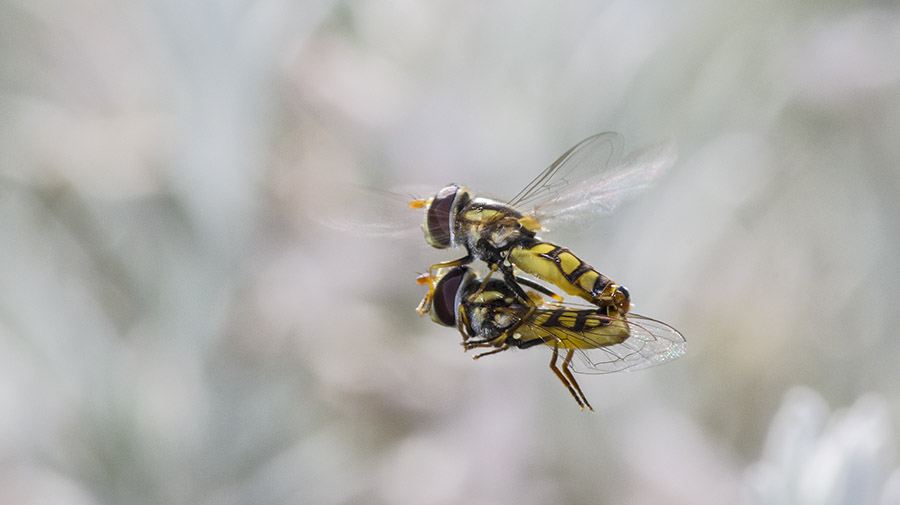
When I was knee-high to a grasshopper, in 1971, the CSIRO released their very heavy hard back book of Australian insects. One of the great publications in world history – when I was at the British Museum later, it was on everyone’s shelf there. Among the amazingly complete treatment of all 600-plus insects Families, were about 8 colour plates. I was a beetle collector as a callow youth, and I salivated over the beetles page, hoping to at least see all the dudes illustrating it. So one of the Leaf Beetles, Chrysomelidae, with a glamorous colour pallete, has only taken 50 years to materialise, right here right now. Its colours are impossible to capture by camera in sun, or in full flash. In shade at the right angles some of the magic is revealed, but then the light levels make the capture speeds verrrry low, like 1/15th of a second. Hence the pic below is not as pin sharp as I hoped, trying to hold the camera steady.


Intermission…
Just a little aside to tell you the tale of Dr Maitana, a genius, and what modern, lesser, humans have done to throw his legacy away. He was the head designer at Olympus from about 1975. He is responsible for the best cameras ever made, the OM series of SLR cameras back then – film of course. They were the smallest, smartest, most practical and innovative tools in the photography bag. He found a way for flashes to read the light falling on film, through the lens, DURING exposure. This meant we went from dumb manual flashes, to perfect shots every time, from portraits, to insects, to inside caves. This amazing idea, was called TTL metering. All other brands eventually followed this idea, all the way into the digital age. But then, in this age of blaaaaah, dumb-app-minded miasma, someone decided to randomly tinker with what aint broke… they decided that since there was no film inside, TTL could not work as well, so they changed it to a system whereby the flash fires a pre-flash, meters the return, and then fires the flash proper. Look below at one of my fav NOT, results of this, literally, thoughtless idea.


Notice something not quite right about these photos taken with a modern P-TTL camera system ? No subject, or better still, half a bum of a retreating subject. Yep, to many insects, the pre flash says ‘get me outta here’ and insect reaction times are more than good for doing so in fractions of a second. Below is the photo finally working after 8 tries, during which the bee-fly got bored with running away (unfortunately most of the time, they do not return).

Oh, and did I tell you that to add insult to injury, these modern flashes are less accurate, and cameras’ software is told they are not allowed to use the older better ones.. If you ever find this an issue in your photographic life, please join me in sending a few thousand emails to the humans who should have know betterer. All brands equally guilty.
ps – and the punch line – this is a MACRO flash in question, ie ‘designed’ totally for subjects like insects.
…back to Memory Blob #14 the South Oz travels
After a few wasted days in quarantine, caused by the luck of being on a plane with a covid positive dude, I is back on the road. The Eyre Peninsula of South Oz. Weather still cold, plants super happy after big rains, but insects still missing in action. So look deeper. I often investigate flat animals on the road, and find some of the many leayers of insects that make use of this resource. The dude below, on a wallaby leg bone, is a larva of the beetle Family Dermastidae, the so called Museum Beetles. They meticulously eat all the drier details of a carcasse after flies have taken care of the wet slop. Museums have secret rooms where these beetles are preparing skulls and skeletons for display and storage. They have to be be hermetically sealed away from the musuem proper, or all the non skleleton diaplays would turn to dust.

While driving around the coastline here I found this stand out small scene. Near the nicely named Coffin Bay, this little island sure looks like birdies have loved it for eons – look at that icing cake guano (right proper word for bird poo) top

It was time for more inland exploring. Up to Ceduna, and then north into the sand dune country, my old habitat from 6 years of chasing plague locusts around the SA deserts, decades ago. Always feel betterer in sand. This officially ‘semi-arid’ habitat starts where my fav grass starts, the cute spinifex. It grows ever so slowly, getting bright green after rain, and then dies out from inside out, becoming an ever larger circle, with no grass in the middle.


Here among tiny flowering gums, finally saw a few six-legs. Even the only jewel beetle, the numba-wan wish list for this expedition.
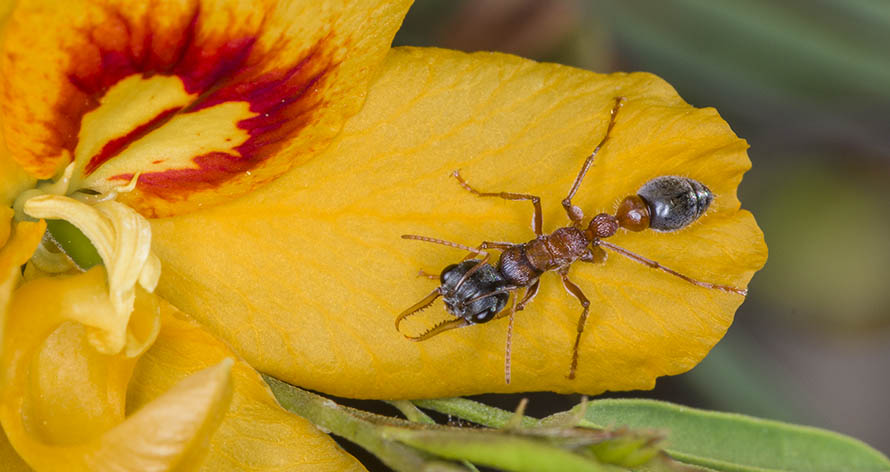



The unremarkable jewel beetle, bottom left, only cost about $4000 and 2 weeks of looking. The fun and games of ‘hunting’ six legs, doesnt get a better defnition. It is always worth the time spent, as the process is everything (and utterly unpredictable). Mr sparkle, the Tenebrionid beetle on the right, is pretty shmick but. Mid left is a fish beetle, Family Mordellidae, and top left, a fun loving bull ant.
Now towards the end of the sequence, it was time to enter a famous area I had never seen before – the Gawler Ranges. Half way between Ceduna and Port Augusta, they are an ancient rounded hill range, with some very cute surprises. South of tha range are several granite outcrops that represent single ‘rocks’ on an Uluru scale (counting what is not above ground). One of them, is even a mini-me wave rock look alike, the Pildappa Rock.



And deeper into the Range, two areas show what happens when volcanic magma cools verrry slowly and forms long ‘crystals’ of rock. One area is called the Organ Pipes, the other is harder to find, and has no warning that it is just as amazing.


The other ‘pipes’ with the fun name of Mirica Falls. Locals were saying the good rains have been way, way above normal, and so this ‘Falls’ was actually trickling down the smooth rockface.


Two aside observations: to get to the dune country one has to cross the famous dog fence. You would not want to be a dingo on the north side, with a wish to travel south.

Oh, and among the huge rocks south of the Ranges, are areas of silly-bugger larrikin rocks, that don’t care about rules, or gravity. This bozo felt obliged to help.

So all travels end. But before departing, one had to visit one of the land/habitat types that SA is famous for – a proper god-fearing white salt lake. This one is Lake Giles, a bit E and S of the Gawler Ranges.

Memory blob #15
There’s a tiger in my tank
So how many readers are ancient enough to remember the good ol days when ads were a novelty and we believed them all ( well, some) ? Esso had a very successful campaign with putting tigers into docile 1960’s cars


But oddly I want to talk about other tigers – the beetle variety. A Family called Cicindelidae, related to the big family of hunting beetles called the Carabidae. Tiger beetles have always had a special place in my little boy heart. I remember chasing a silver coloured species that lives on beaches, and is so fast it runs down flies before they can take off. I don’t have a pic of it here, but when I started travelling to Borneo, I found a better, sexier long-legged version of it
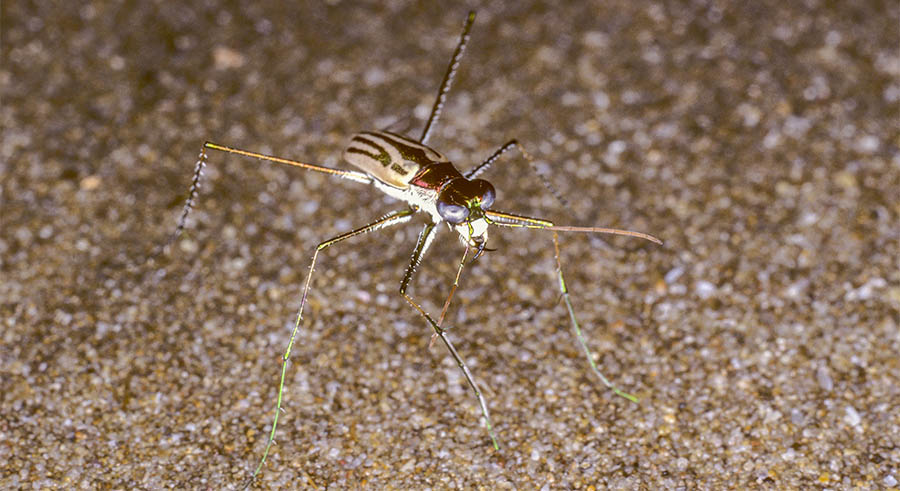
How much more super-car, or gazelle, can you get. It too ran like the clappers, and I spent a verrry looooong time getting them habituated to my presence before getting that shot. Look at those crossed scimitar jaws, and gorgeous legs. Most species were in one genus called Cicindela, and looked very much like this, minus the super long legs. Other genera specialised in habitats other than exposed sand plains. Rainforests have some great weird examples.





Sweet. Below is one of a group of ruggedly built flightless species, in the genus Tricondyla, found from Cape York in Oz to most of Tropical Asia

And then there are the babies. Fully nasty pieces of work. They are not just hunters, but unfair, sneaky little buggers. So imagine you are an ant, or other ground trundling insect, concentrating on getting from a to b, and then out of the flat no-warning land ahead, a huge jack-in-the box monster erupts backwards, and grabs you in its eeecky jaws…


Not a pretty sight. These guys dig vertical burrows and then sit therein, with their modified flat head at the entrance, invisible, except from above. They really do spring out, just like a jack-in-box, albeit armed with nasty mandbiles that grab you and take you into the burrow depth for devouring. Here is a drawing, from the Time/Life INSECTS book. I added the red arrow to show you its clever body claws that anchor it in the burrow, even when it is extended out grabbing prey. If the vistim winds up being a tough hombre, it cannot drag out the larvae in the fight.

And now for the big story. When I was a tiny kidloid in Poland in the sixties, I had an encyclopaedia of animal life, very guilty of getting me started on a life of insect bothering. Among many images there was one, of the world’s largest tiger beetle. I wanted it bad. And it took until 2016 to see my first, of two species, on an expedition through South Africa. These monsters, 6 to 7cm long, have fantastical jaws and a fearless attitude problem. The first I saw while looking for elephants in central South Africa, and there it was, munching on a giant millipede that someone had runned over.

And then in a greener part of the country, I found a different, even larger jawed species, hunting poor insects in the leaf litter…

Utter perfection.
ps: the TIME/LIFE – THE INSECTS book, which was first published in 1962, is still one of the absolutely bestest texts on insects on the planet. It is full of all the stories and pictures about their world, that helped me get deeper into this subject as a kidloid. Only one other book since then has approached the readibility and joy of knowledge, and it is a British encyclopedia published by Allen & Unwin in 1986. Both keep cropping up in second hand book shops and Vinnies. Dont miss out if you see one – grab it.

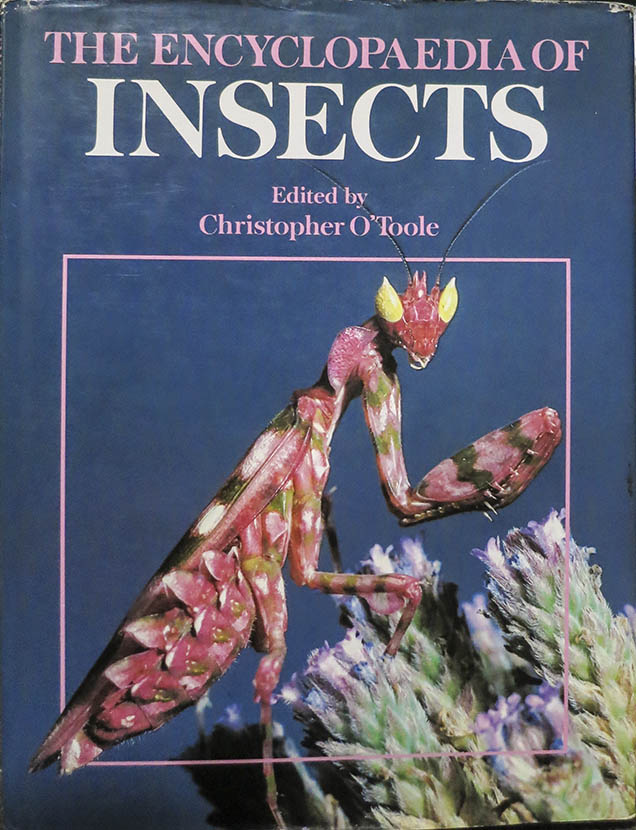
Memory blob #16
8 legs ?
So it is time to admit that any number of legs above 6 is interesting. Spiders will often feature on these pages to come. So lets start with the word spider. Spider Wasps but.
These sometimes large wasps have one mission in life. Find spiders, scare the poo out of them, sting them with a paralysing poison, and drag them back to a burrow where nasty stuff happens. This female wasp lays eggs in the paralysed but not dead spider, and closes the burrow – leaving her babies to devour the critter during their young lives. The Family of wasps is Pompylidae, and one characteristic is the usually bright antennae with a cute curl at the end. The wasps shake, shimmy and vibrate these antannae when approaching a spider. It looks like the sider should be able to either kill the wasp or run away, but neither happens. The prey seems to be hypnotised by the wasp, which comes in for the ‘kill’ with seeming ease. Then depending on the size of prey, it might have to cut off all the legs to be able to drag it to its prepared burrow. So the following pictures do not all have 8 legs in them, just memory of 8 legs…





So these wasps are feared in the macro world, and maybe that means there are critters mimicking them for general protection… below is a spider wasp, and a fly that are in what is called a Batesian mimicry chain.


The wasp is the one with the proper antennae curl – left. There are mimicry ‘chains’ out there with tens of species. It is a phenomenon first worked on by my great hero, Henry Bates, who was insect collecting in South America at the time Darwin was in the Galapagos, and Russell Wallace was in the Malay Archipelago. All three arrived independently at the theory of evolution. Darwin is famous for obsessing about his finches, but it is easier to see evolution in action by studying the six-legs, as the other dudes did.
HOLD PRESS ! THIS NEWS JUST IN !
This story is going to butt in here on account of just how amaaaazing this news is – on the ABC news site on 17 Dec 2021, here:
https://www.abc.net.au/news/science/2021-12-17/millipede-true-discovered-one-thousand-legs/100696324
Yes six legs is very good, but more is pretty cute too. The absolute maximum, until only just seconds ago, was 750, owned by a millipede species. The Class of millipedes is Diplopoda, which means two legs (per body segment), and the word millipede literally means ‘one thousand legs’. However none to date had 1000 legs – that would be almost silly to consider – and yet this new species from rock fissures 60m deep, in central QLD, has 1306 legs !! See the article for more on this champion of champions, but while we are here, might as well tell you more about this group in general. About 12,000 species worldwide. And did you know that when they are first hatched from their eggs, they have only 3 to 4 pairs of legs, and get more with each moult as they grow.
Below is your typical garden variety species in Oz. Not too exciting looking, as they trundle about on – how many legs ? there will be an exam at the end of this blob, so start counting – you can cheat if you like, by just counting the segments and then times that number by 4 – two on each side of each segment.

Now go to the jungles of the world, where the eeky decomposing veg material, fungi and mosses abound – the diet of most milllipedes – and the variety and sizes get nicely weird. Lets go straight to Borneo first. The dudes in the two pics below are doing that thing that makes babies, and they stay like this for hours. Note the next pic that shows how sweet they is, kissing like there is no tomorrow.


Hope you are still counting. The next story is fully weird. Still in Borneo in a very wet forest with a big white fungal blob on an old tree, and hundreds of these wriggling beauties eating it from all sides. This writhing mass is fully half a metre across.


Another type of millipedes have flattened bodies with armour-plate like segments. Next pic is from Ghana, and then the close up below it, is from Malaysia.


But my favouritest millipedes are the pill-millipedes. They only have around 12 fat segments, but these fit together in a perfect concertina fashion that allows them to roll into a defensive shiny ball.
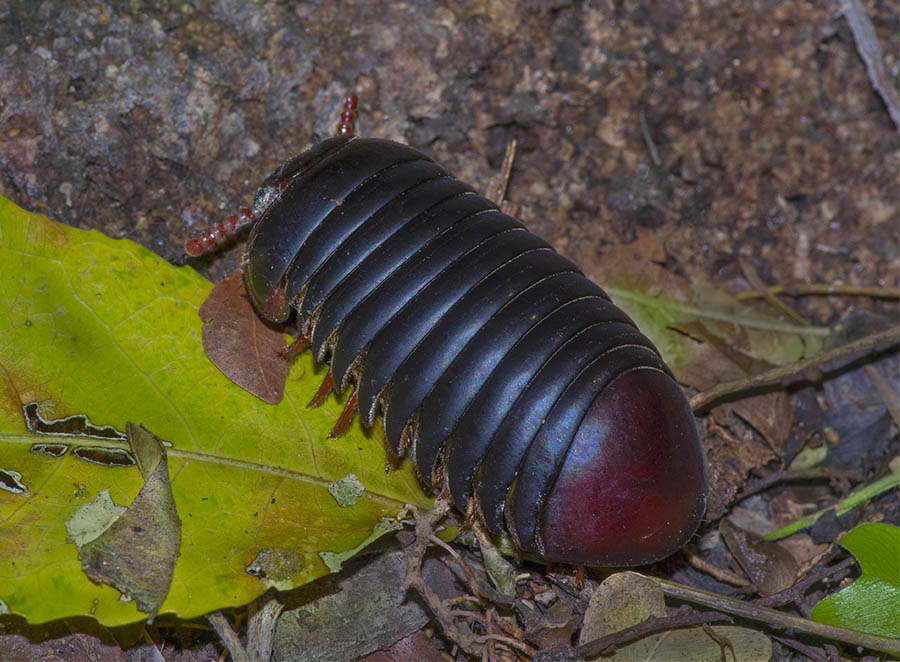


These pill millipedes are from Madagascar, where all weird stuff lives. Oz has a few too, but only dull littlies. The gorgeous golden trilobite-esque one here, is 12 cm long.
Oh and much sorry. There will not be an exam, as it would mean I would have to go mad counting them too. But if you have the answers, send them in.
Memory Blob #17
Assassins I have known.
The following story is about killer bugs, that other insects are not happy to meet. The 7000 species of Assassin Bugs, Family Reduviidae.
The word ‘bug’ is not interchangeable with all insects (as the Americanos misuse), but refers to an Order of insects, the Hemiptera, which are characterised by having their mouth parts modified for sucking. No chewing jaws at all. The majority of true bugs, and the hoppers and scale insects and aphids and such, in this Order, are vegetarians. They insert the beak-like rostrum into plants and seeds and suck out the juices. The assassins and several Families of aquatic bugs, stick their rostrums into other critters. And this is the grizzly part – to be able to suck out the contents of the prey, they have to first inject digestive juices to liquefy the innards. So below is a typical Oz species. Note the ‘neck’ before the head, and the strong looking downward curving, sharp, rostrum.


The yellow one above, is just a show off, parading about with the poor Trigona bee impaled on its rostrum. The one below, with the 60’ties fluffy leggins, is a termite hunter. Both are Australian.

Among dangerous and not so dangerous insects, there is always the chance of mimicry. Below is a species of assassin bug which is scary to its prey, but larger creatures can eat it, without hassle. So this one mimicks a ‘velvet ant’ (on the right), a group of wasps with wingless females which live on the ground and defend themselves with super duper stings.


Mimicry from the other side of the equation, sees a harmless seed sucking bug, below left, mimic an assassin bug in Mozambique, right.


Ambush is not a bad strategy for hunters, and the act of hiding thus, can also be a way to keep predators off your back. A whole bunch of species have sticky bodies and either cover themselves with earth/sand, or with a chaotic mess of bodies of your prey – both do not look like an insect to eat. In the case of the red earth one (left below), it is perfectly camaouflaged against the red earth of termite mounds, and termites are its prey.


A sub-group of assassins, the sub-Family Emesinae, have long, delicate, skinny shapes, and have evolved the raptorial forelegs that mantids hunt with. Some hunt out in the open, on leaves, some even move about on spider webs and hunt the spiders, (below), and others live in caves. The red picture (blow, below) is of a large, 30mm, species from inside the lava tube caves inland from Cairns. Note its extremely long legs and antennae, to help it move and hunt in the dark.


And just a few more gratuitous pics of fun assassins…
Top left is a wingless species from Mozambique. Bottom left is a baby in New Guinea. Top right also from New Guinea. And the yellow dude is one that imitates local large carpenter bees, in Ecuador.
Memory Blob #18
The New Studio for Donatello, and old wet memories
As a boy I got down and dirty playing in ponds, and bringing back aquatic insects to observe in my aquarium. Hours of fun and games. The drama of life and death struggles, the growth cycles of critters, and the surprises of who turned out to be king of the pool. So this summer an aquarium is set up in my studio, and slowly critters are pupulating it. The first dude was a diving beetle larvae, Family Dytiscidae. These streamlined beetles, have back legs adapted like oars, to rapidly paddle underwater, and they store air under their wing cases for long dives – see the beetle below with air stored both under the wing cases, and in an extra bubble. When ponds dry up, they can fly to new ones too, and leave eggs as they go. One such egg hatched into Donatello (below left), my pet larva from a pond in Sydney, with its ferocious jaws, patrolling the aquarium empire.



So above, he is chewing on number 1 good tucker, a bloodworm. These wrigglies are not worms but the larvae of harmless gnats in the Family Chironomidae. The colour comes from heamoglobin, the same stuff in our own blood, which carries oxygen. Because these larvae live in the bottom muck, they need extra oxygen carrying capacity. They are a great source of protein for all carnivorous water insects and baby fish. Note the pointy ‘tail’ of Donatello. It is a breathing syphon tube that it brings to the surface to pick up a load of air for long dives.
So far very few dudes in the aquarium. One lone damselfly nymph shares the space – it too is a carnivore, and the three ‘tails’ are its gills. It does not need to come to the surface for air, as Donatello does.


Above is your typical water snail. Great ‘gardeners’ of the habitat, eating the algae off the glass and keeping the place clean. They are both girl and boy in the same body, so after mating, either or both lays a mass of eggs in jelly. These are stuck to water plants and rocks, and in this fun case, to the other snail.
…. days later and there is a development in the water world. I gave Donatelo two more other diving beetle larvae to live with, and hunt mozzi wrigglers with. However the tooth-and-claw world of nature saw it differently, and Donatelo chose to eat his new companions. The small world of a pond is a very dangerous one, with everyone literally looking out only for themselves.

Memory Blob # 19
The CLAW family
A long time ago, in Cairns, I had another wet studio. There the critters that lived therein were larger, meaner and were generally possessed of even more attitude. For a while the aquarium was the empire of claws. That is, it housed various freshwater murderous prawns !! One species is actually asymmetrical – a super rarity in the world of living things, in that it possessed one claw larger than the other. It’s Latin name is Machrobrachium latimanus – Latin is great, here it describes it perfectly: macro = large, brachium = arm, and lati = wide, and manus = hand. The naming of life is a very satisfying thing in itself.
Thus he was of course named CLAW, and very scared were critters in the tank, which inevitably became his supper.

He ate other water insects, little fishies, and non aquatic beasts like grasshoppers, that someone put in the tank… But they is not long lived, and after his sad demise, I CLAUDIUS was found to rule the empire. Here he is in his cave of solitude.

Even he did not last to posterity, and the next empire boss was a girl, CLAUDETTE. She was tiny compared to the boys, but more than made up for it with attitude. Prey size did not matter to her narly attack-doggi self.

After the age of CLAWS, came the age of TONGS.
The largest aquatic insects are the well named giant fish killer bugs, Family Belostomatidae. 8 centimetres of calm cool murderous intent. The front legs are adapted into giant ice tong-like pincers that both stab and grab passing prey, which indeed does include hapless fish.


In the pic above he is sucking on a grasshopper. He belongs to the true bugs Order, Hemiptera, which means he has no mandbiles for chewing. All mouth parts are fused into a stabbing beak-like tool called a rostrum. So to eat prey, he first injects stomach acids into it, and then sucks up the liquefied contents.
Closely related to the fish killer bugs, are water scorpions. They are also bugs, with the piercing rostrum, and can be as long, but more skinny. Armed with either stabbing, or grabbing front legs (grasping like a mantid), and a long breathing siphon at the back. Here one of the pets is observing passing prey, while the other (pic below this one) is sucking up a fish. Tanks need little fishies to eat mozzi wrigglers before they hatch – in the house.


And in the tooth-and-claw world of survival, the pets had an argument about hunger and supremacy, and the bigger water scorpion won. It was a sad day in the aquarium….

Memory Blob # 20
Harmless, Hidden, Cute, herbivore….
After the unmittigated blood-spattered carnage and narliness of the last two blogs, it is defnitely time for a nice sweet, harmless entry. The most vegeterian, self-effacing, would not harm a fly cretures I can think of, are stick insects. All they want to do is not be noticed by you, and to get on with munching leaves. There are about 2500 species of these critters, most of which imitate sticks, bark, moss and other aspects, of especially, the jungles of the world. So first, lets look at typical stick types, doing the thing they do in daytime – behave like sticks, and then do their feeding under the cover of night.
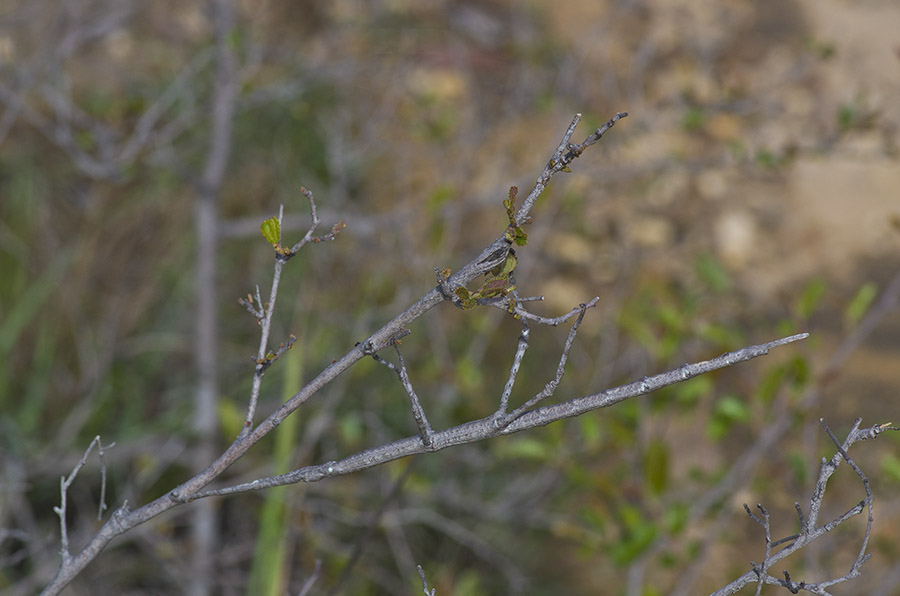

The skinny stick above, in Borneo, is keeping very tight against the lichen-covered bark it is imitating. This is so as not to cast shadows, which are very revealing. When I see a well behaved stick, ie, one that behaves like a stick or other part of the scenery, I always disturb it to see if it has a secondary defense. This one suddenly leapt backwards off the trunk and landed in the messy leaf litter on the ground. Took ages to find it, because its secondary defense was to break up its straight stick shape with 90 degree bends, and show its upside down colours – not tree trunk imitators, but leaf litter colours. Have fun looking for it below.





So the sight of this 30cm (a full ruler long !!!!) stick insect was not as visible as one might think. And did you notice the tiny boy attached to this huge female ?
After doing that thing that makes babies, as the pair above are enjoying, the female lays eggs singly and often, just dropping them to the ground. There they mimic various seeds, which fools some egg predators. They are works of art in themselves…




